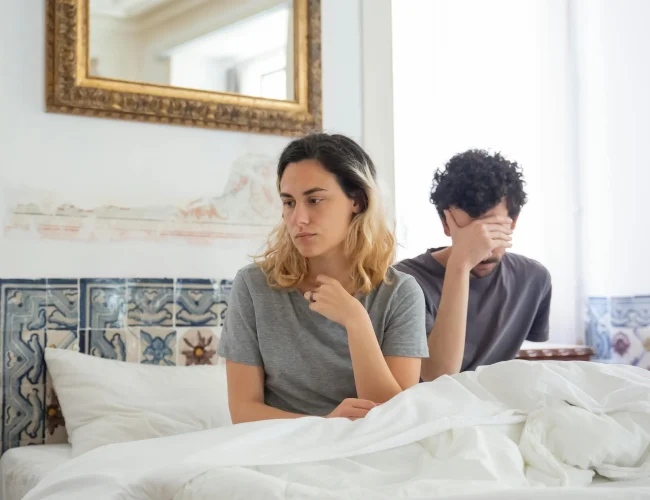By Alice Bourne
This blog is a summary of our published article:
Bockaj, A., Muise, M. D., Belu, C. F., Rosen, N. O., & O’Sullivan, L. F. (2024). Under pressure: Men’s and women’s sexual performance anxiety in the sexual interactions of adult couples. Journal of Sex Research, 1–13. Advance online publication. https://doi.org/10.1080/00224499.2024.2357587
What is sexual performance anxiety?
Sexual performance anxiety is a phenomenon that affects approximately 9% to 25% of men, and 6% to 16% of women [1]. It refers to an individuals’ concerns surrounding their ability to please and/or satisfy their partner during sexual activity [2,3]. Previous, research on sexual performance anxiety in men is usually about sexual dysfunction (such as erectile dysfunction and premature ejaculation) [4, 5, 6]. However, little research has addressed women’s experiences with sexual performance anxiety or how it affects relational dynamics [3, 7].
What did we want to know?
Our study aimed to explore the experiences of individuals with sexual performance anxiety and the strategies that they use to cope with it. We also examined how sexual performance anxiety was linked to relationship dynamics and its effects on both relationship and sexual satisfaction.
What did we do?
We conducted two different studies. Study 1 recruited 51 participants. Participants were asked to describe their cognitive (thoughts, thinking, reasoning) and affective (moods, feelings, attitudes) experiences, coping strategies, and how they perceived the impact of their experiences with sexual performance anxiety on their relationship using open-ended questions in online surveys.
Study 2 recruited 228 couples (456 participants). Participants were given a survey which asked participants questions about sexual performance anxiety, sexual distress, sexual satisfaction, and relationship satisfaction.
What did we find?
Study 1
In Study 1, participants were asked to describe the thoughts and feelings that emerged when they experienced sexual performance anxiety. We grouped their responses into three categories: feelings of inadequacy, physiological and low arousal, and distraction.
- Feelings of inadequacy was the most common response among individuals in our study. Responses in this category described experiences of feeling unattractive, not sexually skilled, embarrassed, or comparisons of their sexual abilities to those of their partner’s past lovers.
- Physiological and low arousal responses included descriptions of anxious thoughts during sex about their physiological performance, such as being able to maintain physical arousal, and reaching climax.
- Distraction responses included racing thoughts during sex, and difficulty to “be in the moment” during sex. Participants often reported thinking about stressors during sexual activity, such as their home or personal life.
We also identified two different methods that individuals with sexual performance anxiety used: approach and avoidance strategies. Approach strategies are strategies that are used to enhance or create positive outcomes in one’s relationship. Strategies include descriptions of individuals continuing to engage in sexual activity for their own or their partner’s pleasure, despite feeling anxious about their sexual performance. This could involve communicating their discomfort and sexual needs to their partner, or engaging in different types of sexual activities. Avoidance strategies are strategies that are used to avoid negative outcomes in the relationship. Avoidance strategies include finding a way to not have sex altogether or alternately, continuing to engage in sex to avoid making their partner upset.
Study 2
In Study 2, we found that when individuals reported higher levels of sexual performance anxiety, the individual and their partner reported higher levels of sexual distress, and lower levels of sexual and relationship satisfaction.
What does this mean?
Sexual performance anxiety experience can impact a relationship. In Study 1, women seemed to focus on thoughts of sexual inadequacy, specifically, their ability to be sufficiently attractive for their partner. Men seemed to focus more on their physiological arousal, such as their ability to maintain an erection. These thought processes could be explained by sexual scripts, as men are socialized to always be ready for sex, whereas women are socialized to be valued in terms of their physical appearance.
Additionally, sexual performance anxiety may reflect an overall inability to be present in the sexual moment, to feel genuine sexual responses as they occur, and to enjoy sex. This anxiety could also detract from a partner’s experience during sex, which may explain lowered sexual and relationship satisfaction, and increased sexual distress in the individual experiencing anxiety, as well as their partner.
Future studies should examine treatment options for individuals coping with sexual performance anxiety. Therapists could target individual’s beliefs about sexual function, and common scripts and beliefs within individuals and couples, which could help foster new sexual behaviours.
References
[1] Pyke, R. E. (2020). Sexual performance anxiety. Sexual Medicine Reviews, 8(2), 183–190. https://doi.org/10.1016/j.sxmr.2019.07.001
[2] Masters, W. H., & Johnson, V. E. (1970). Human sexual inadequacy. Little, Brown.
[3] McCabe, M. P. (2005). The role of performance anxiety in the development and maintenance of sexual dysfunction in men and women. International Journal of Stress Management, 12(4), 379–388. https://doi.org/10.1037/1072-5245.12.4.379
[4] Cranston-Cuebas, M. A., & Barlow, D. H. (1990). Cognitive and affective contributions to sexual functioning. Annual Review of Sex Research, 1, 119–161. https://doi.org/10.1080/10532528.1990.10559858
[5] Hawton, K. (1993). Sex therapy: A practical guide. Oxford University Press.
[6] McCabe, M. P., & Connaughton, C. (2014). Psychosocial factors associated with male sexual difficulties. The Journal of Sex Research, 51(1), 31–42. https://doi.org/10.1080/00224499.2013.789820
[7] Dang, S. S., Northey, L., Dunkley, C. R., Rigby, R. A., & Gorzalka, B. B. (2018). Sexual anxiety and sexual beliefs as mediators of the association between attachment orientation with sexual functioning and distress in university men and women. The Canadian Journal of Human Sexuality, 27(1), 21–32. https://doi.org/10.3138/cjhs.2017-0025












